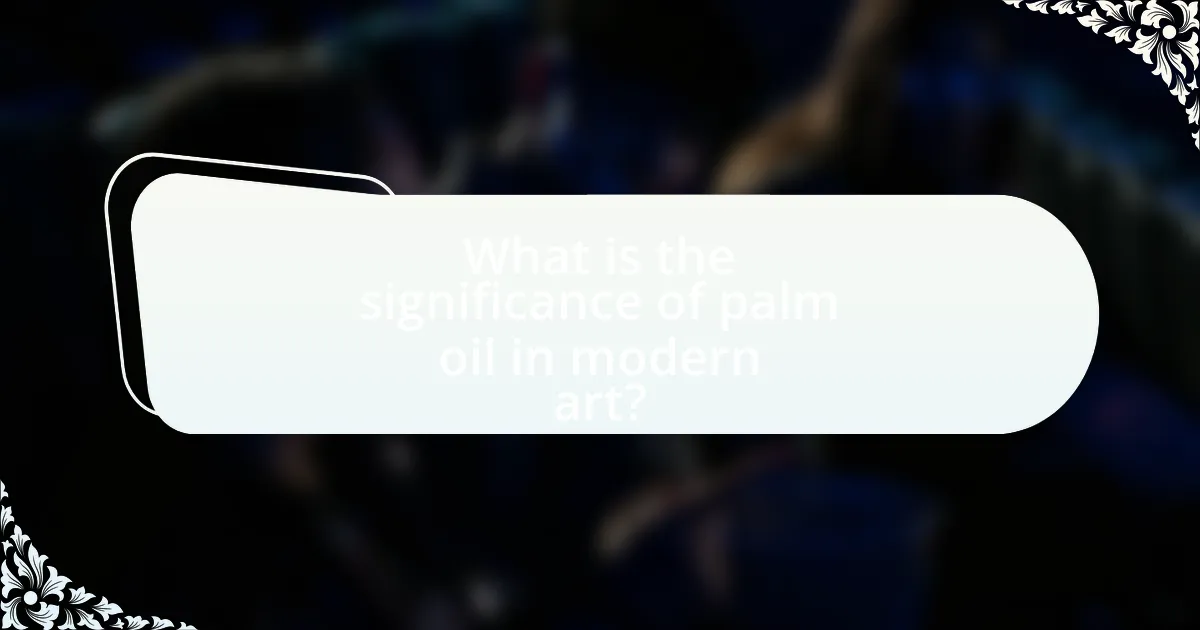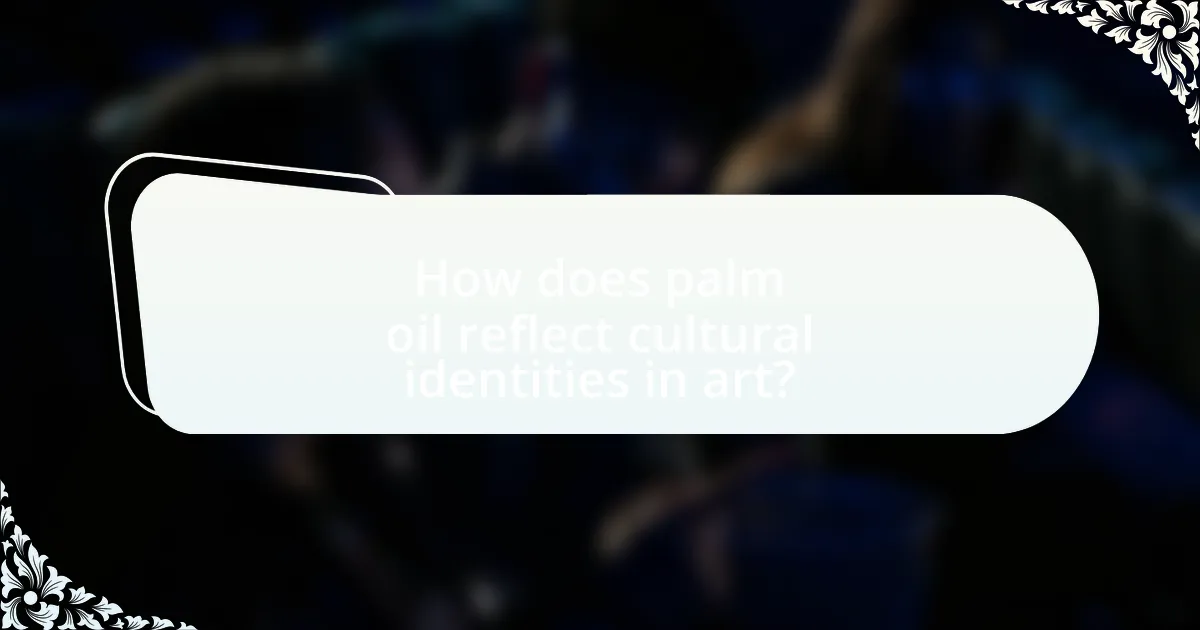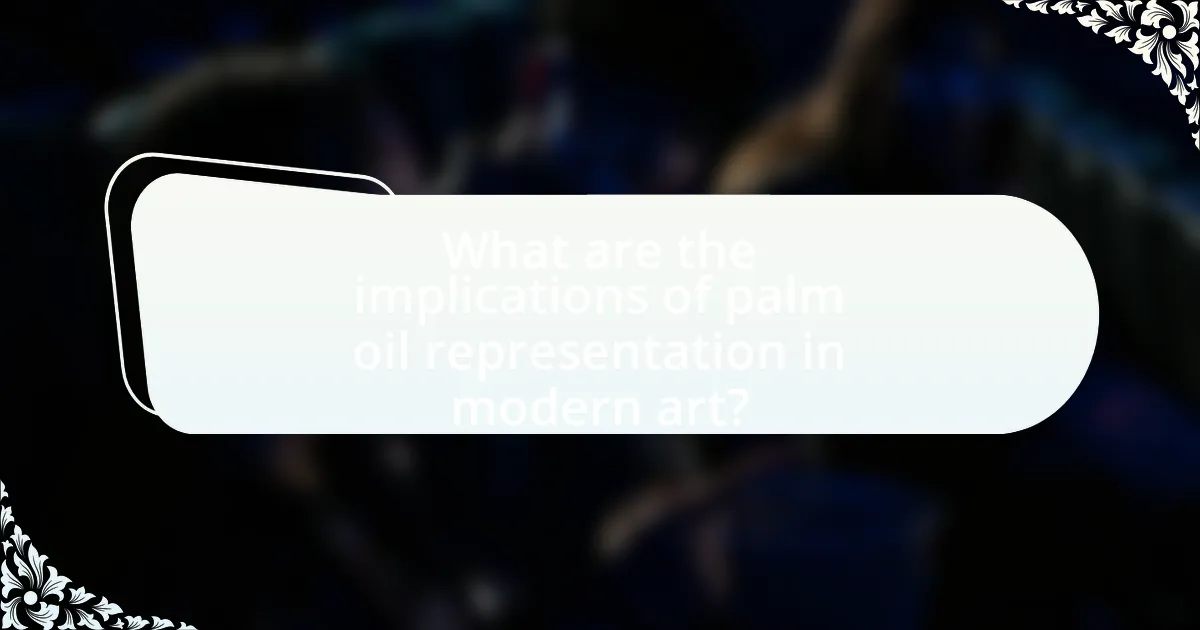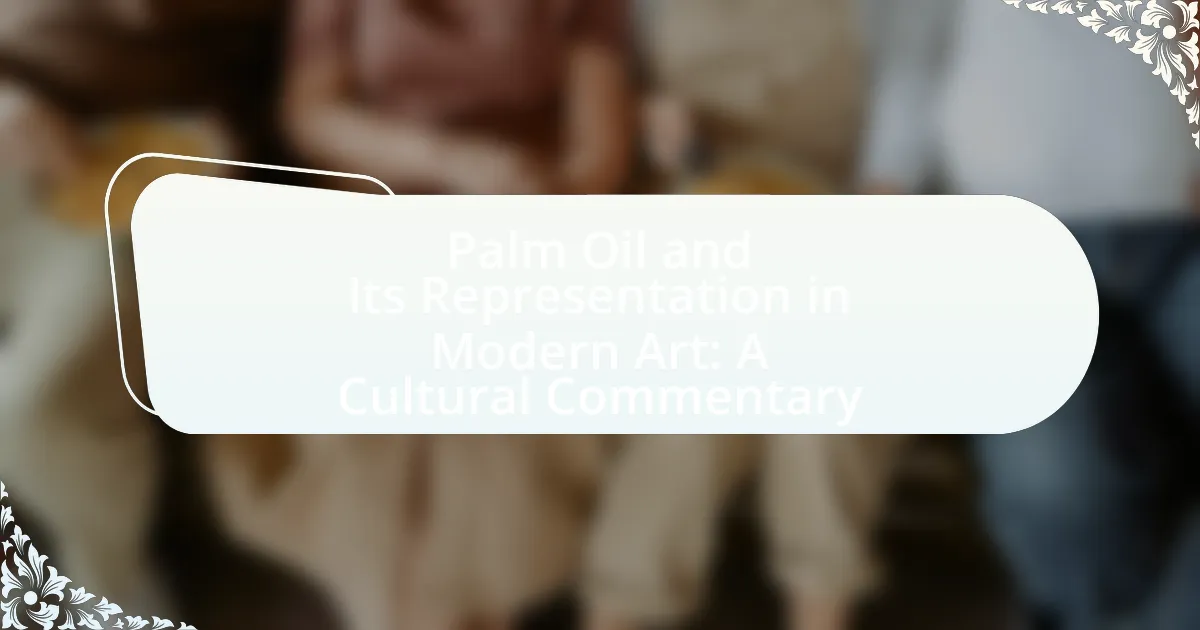Palm oil is a significant subject in modern art, serving as a medium that reflects socio-economic and environmental issues. Artists utilize palm oil to critique its production’s impact on deforestation, biodiversity loss, and indigenous communities, often incorporating it into their works to foster dialogue about sustainability and ethical consumption. The article explores how palm oil is represented in contemporary artworks, the themes associated with it, and the implications of its portrayal, highlighting the intersection of cultural identity, consumerism, and environmental degradation. Additionally, it discusses the role of artists in challenging perceptions of palm oil and advocating for sustainable practices through their work.

What is the significance of palm oil in modern art?
Palm oil holds significant importance in modern art as a medium that reflects socio-economic and environmental issues. Artists utilize palm oil to critique the impact of its production on deforestation, biodiversity loss, and indigenous communities. For instance, the work of artists like El Anatsui incorporates palm oil packaging to comment on consumerism and waste, highlighting the intersection of art and activism. This use of palm oil in art not only raises awareness but also fosters dialogue about sustainability and ethical consumption, making it a powerful tool for cultural commentary in contemporary artistic practices.
How has palm oil been represented in contemporary artworks?
Palm oil has been represented in contemporary artworks as a symbol of environmental degradation and socio-economic issues. Artists utilize palm oil to critique the deforestation and biodiversity loss associated with its production, often highlighting the conflict between economic development and ecological sustainability. For instance, works by artists like Yao Jui-Chung and the collective “The Otolith Group” incorporate palm oil imagery to provoke discussions about colonialism, exploitation, and the impact of global consumerism on local communities. These representations serve to raise awareness and encourage dialogue about the ethical implications of palm oil consumption in a globalized world.
What themes are commonly associated with palm oil in art?
Common themes associated with palm oil in art include environmental degradation, colonialism, and consumerism. Artists often depict the ecological impact of palm oil production, highlighting deforestation and loss of biodiversity, which are critical issues linked to the industry. Additionally, the theme of colonialism is prevalent, as palm oil production is rooted in historical exploitation of land and resources in tropical regions. Consumerism is also a significant theme, as artworks critique the demand for palm oil in global markets, reflecting on its role in everyday products and the ethical implications of consumption. These themes are reinforced by various artists who use their work to raise awareness about the socio-political and environmental consequences of palm oil cultivation.
How do artists use palm oil as a medium or subject?
Artists use palm oil as a medium and subject to explore themes of environmentalism, consumerism, and cultural identity. By incorporating palm oil into their artwork, they highlight the ecological impact of palm oil production, such as deforestation and habitat destruction, which are critical issues in contemporary society. For instance, artists like El Anatsui utilize palm oil in their installations to comment on the socio-economic implications of its trade, reflecting on the interconnectedness of global markets and local communities. This approach not only raises awareness but also invites viewers to engage with the complexities surrounding palm oil, making it a powerful tool for social commentary in modern art.
Why is palm oil a controversial topic in cultural discussions?
Palm oil is a controversial topic in cultural discussions due to its significant environmental impact and socio-economic implications. The cultivation of palm oil has led to widespread deforestation, threatening biodiversity and contributing to climate change, as evidenced by the loss of approximately 3.5 million hectares of rainforest annually for palm oil production. Additionally, the industry is often linked to human rights abuses, including land grabbing and poor labor conditions, which raises ethical concerns among consumers and activists. These factors create a complex dialogue around palm oil, influencing cultural perceptions and artistic representations in modern art.
What are the environmental impacts of palm oil production?
The environmental impacts of palm oil production include deforestation, loss of biodiversity, and greenhouse gas emissions. Deforestation occurs as vast areas of tropical forests are cleared to establish palm oil plantations, leading to habitat destruction for numerous species, including endangered ones like orangutans and tigers. According to the World Wildlife Fund, palm oil cultivation is responsible for approximately 10% of global deforestation. Additionally, the conversion of forests to plantations releases significant amounts of carbon dioxide, contributing to climate change. The Rainforest Foundation reports that palm oil production is linked to the emission of over 1 billion tons of CO2 annually. Furthermore, the use of pesticides and fertilizers in palm oil farming can lead to soil degradation and water pollution, further exacerbating environmental issues.
How do these impacts influence artistic representation?
The impacts of palm oil production, including environmental degradation and social injustice, significantly influence artistic representation by prompting artists to address these critical issues through their work. Artists often use their platforms to critique the unsustainable practices associated with palm oil cultivation, such as deforestation and habitat destruction, which can be seen in works that incorporate imagery of affected landscapes or endangered species. Additionally, the social implications, such as the displacement of indigenous communities, inspire artists to create pieces that highlight human rights violations, thereby fostering awareness and dialogue around these topics. For instance, contemporary art exhibitions have featured installations that juxtapose the beauty of tropical landscapes with the stark realities of industrial agriculture, effectively engaging viewers in the conversation about the ethical implications of palm oil consumption.

How does palm oil reflect cultural identities in art?
Palm oil reflects cultural identities in art by serving as a medium that embodies the socio-economic and environmental narratives of communities involved in its production. Artists utilize palm oil to comment on the complexities of globalization, colonial histories, and indigenous practices, often highlighting the juxtaposition between traditional values and modern exploitation. For instance, contemporary artists from palm oil-producing regions may incorporate the substance into their works to symbolize the cultural significance of palm oil in local economies and its impact on land use and biodiversity. This artistic representation can be seen in exhibitions that address the consequences of palm oil cultivation, such as deforestation and displacement, thus reinforcing cultural identities tied to land and heritage.
What cultural narratives are conveyed through palm oil in art?
Palm oil in art conveys narratives of environmental degradation, economic disparity, and cultural identity. Artists utilize palm oil as a medium to critique the deforestation and biodiversity loss associated with palm oil production, highlighting the ecological consequences of industrial agriculture. For instance, works by artists like Eliza Southwood illustrate the tension between economic benefits and environmental costs, emphasizing the plight of indigenous communities affected by land exploitation. Additionally, palm oil serves as a symbol of cultural heritage in regions where it is traditionally cultivated, reflecting the complex relationship between local practices and global markets. This duality in representation underscores the socio-economic challenges and cultural significance tied to palm oil, making it a powerful subject in contemporary art.
How do different cultures interpret the symbolism of palm oil?
Different cultures interpret the symbolism of palm oil in various ways, often reflecting their historical, economic, and spiritual contexts. In West African cultures, palm oil symbolizes prosperity and is integral to traditional rituals and communal gatherings, representing abundance and nourishment. In Southeast Asia, particularly in Indonesia and Malaysia, palm oil is often associated with economic development and modernization, symbolizing progress and industrial growth. Conversely, in some indigenous communities, palm oil can symbolize environmental degradation and loss of ancestral lands, highlighting the tension between economic benefits and ecological sustainability. These interpretations are shaped by local practices, beliefs, and the socio-economic impacts of palm oil cultivation, illustrating its multifaceted symbolism across different cultures.
What role does palm oil play in the identity of specific communities?
Palm oil serves as a crucial economic and cultural element for specific communities, particularly in Southeast Asia, where it is integral to their livelihoods and traditions. For instance, in Indonesia and Malaysia, palm oil cultivation provides employment and sustains local economies, with millions of people relying on it for their income. Additionally, palm oil is embedded in the cultural practices and social structures of these communities, often associated with traditional ceremonies and local cuisine. The significance of palm oil is further highlighted by its contribution to national economies, as both Indonesia and Malaysia are among the largest producers globally, accounting for approximately 85% of the world’s palm oil supply. This economic importance reinforces the identity of these communities, linking their cultural heritage with agricultural practices and global trade dynamics.
How do artists challenge perceptions of palm oil through their work?
Artists challenge perceptions of palm oil through their work by using visual narratives that highlight the environmental and social impacts of palm oil production. For instance, installations and paintings often depict deforestation, habitat destruction, and the plight of indigenous communities affected by palm oil plantations. These artistic representations aim to provoke critical discussions and raise awareness about the unsustainable practices associated with palm oil cultivation. A notable example is the work of artist Subhankar Banerjee, who captures the beauty of threatened ecosystems, thereby contrasting the destructive consequences of palm oil expansion. This approach not only informs viewers but also encourages them to reconsider their consumption choices related to palm oil products.
What techniques do artists use to provoke thought about palm oil?
Artists use techniques such as visual symbolism, immersive installations, and provocative imagery to provoke thought about palm oil. Visual symbolism often includes the juxtaposition of palm oil products with images of deforestation or endangered species, highlighting the environmental impact of palm oil production. Immersive installations engage viewers by creating environments that mimic the ecosystems affected by palm oil cultivation, fostering a deeper emotional connection. Provocative imagery, such as graphic representations of the destruction caused by palm oil plantations, challenges viewers to confront the consequences of their consumption choices. These techniques effectively raise awareness and stimulate critical discussions about the ethical implications of palm oil use in contemporary society.
How effective are these techniques in raising awareness?
The techniques used in modern art to represent palm oil are highly effective in raising awareness about its environmental and social impacts. By utilizing visual storytelling, artists can evoke emotional responses and provoke critical discussions surrounding palm oil production, which is linked to deforestation and habitat destruction. For instance, exhibitions that feature striking imagery of affected landscapes and communities have been shown to engage audiences more deeply than traditional informational campaigns, leading to increased public discourse and advocacy. Studies indicate that art can enhance retention of information and motivate action, as seen in campaigns that have successfully mobilized support for sustainable practices in the palm oil industry.

What are the implications of palm oil representation in modern art?
The implications of palm oil representation in modern art include raising awareness about environmental issues and critiquing consumer culture. Artists utilize palm oil imagery to highlight the deforestation and biodiversity loss associated with palm oil production, which has been linked to significant ecological damage in regions like Southeast Asia. For instance, the World Wildlife Fund reports that palm oil cultivation is a leading cause of rainforest destruction, impacting species such as orangutans. By incorporating palm oil into their work, artists provoke discussions on sustainability and ethical consumption, encouraging viewers to reflect on their own roles in these global issues.
How does the portrayal of palm oil influence public perception?
The portrayal of palm oil significantly influences public perception by shaping attitudes towards its environmental and social impacts. Negative representations in media and art often highlight deforestation, habitat destruction, and human rights abuses associated with palm oil production, leading to increased public awareness and concern. For instance, studies indicate that visual campaigns depicting the adverse effects of palm oil cultivation can result in a 30% increase in consumer willingness to support sustainable alternatives. Conversely, positive portrayals that emphasize sustainable practices can enhance consumer trust and promote responsible sourcing. Thus, the way palm oil is depicted directly affects consumer behavior and policy advocacy regarding its production and consumption.
What are the potential consequences of misrepresentation in art?
Misrepresentation in art can lead to significant consequences, including the distortion of cultural narratives and the perpetuation of stereotypes. When artists misrepresent subjects, such as the cultural implications of palm oil in modern art, they risk undermining the authenticity of the represented culture and alienating communities. This can result in public backlash, loss of credibility for the artist, and diminished trust in the art community. Furthermore, misrepresentation can contribute to misinformation, affecting public perception and policy regarding critical issues like environmental sustainability and cultural heritage. For instance, artworks that inaccurately depict the impact of palm oil production may mislead audiences about its socio-economic effects, thereby influencing consumer behavior and advocacy efforts.
How can art serve as a platform for advocacy regarding palm oil issues?
Art can serve as a platform for advocacy regarding palm oil issues by raising awareness, influencing public opinion, and inspiring action against unsustainable practices. Through visual storytelling, artists can depict the environmental destruction caused by palm oil plantations, such as deforestation and loss of biodiversity, effectively communicating the urgency of the issue. For instance, the artwork “The Palm Oil Project” by artist and activist Yuyun Ismawati highlights the impact of palm oil on local communities and ecosystems, engaging viewers emotionally and prompting them to consider their consumption choices. This form of advocacy not only educates the public but also encourages dialogue and mobilizes support for sustainable alternatives, demonstrating the power of art in driving social change.
What can be learned from the intersection of palm oil and modern art?
The intersection of palm oil and modern art reveals critical insights into environmental issues, cultural identity, and consumerism. Artists often utilize palm oil as a medium or subject to critique the ecological devastation caused by its production, which has led to deforestation and loss of biodiversity. For instance, works by artists like El Anatsui highlight the socio-political implications of palm oil cultivation, emphasizing the impact on indigenous communities and the global economy. This artistic representation fosters awareness and dialogue about sustainable practices and ethical consumption, illustrating how art can serve as a powerful tool for social change and environmental advocacy.
How can artists contribute to sustainable practices through their work?
Artists can contribute to sustainable practices through their work by raising awareness about environmental issues and promoting eco-friendly materials and methods. For instance, artists can create pieces that highlight the negative impacts of palm oil production on ecosystems, thereby educating the public and inspiring action. Additionally, many artists are now using sustainable materials, such as recycled or organic substances, which reduces waste and environmental harm. Research indicates that art can influence public perception and behavior regarding sustainability, as seen in campaigns that utilize visual storytelling to convey the urgency of environmental conservation.
What best practices should artists consider when addressing palm oil themes?
Artists addressing palm oil themes should prioritize authenticity, research, and collaboration. Authenticity ensures that the representation of palm oil issues resonates with genuine experiences and perspectives, particularly those of affected communities. Research is crucial for understanding the environmental, social, and economic impacts of palm oil production, which can inform the narrative and visual elements of the artwork. Collaboration with environmental organizations and local communities can enhance the credibility and impact of the artwork, fostering a deeper connection to the subject matter. For instance, artists can draw on data from the World Wildlife Fund, which highlights that palm oil production is a leading cause of deforestation, affecting biodiversity and indigenous rights. By integrating these best practices, artists can create meaningful and impactful works that contribute to the discourse surrounding palm oil.

Leave a Reply